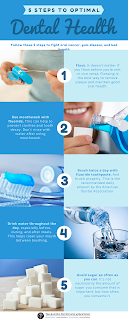Dental Healthcare and Healthy Lifestyle
Taking care
of your teeth at home can help you maintain your dental health and
prevent periodontal, or gum, disease from developing. Richard H. Price, DMD,
spokesperson for the American Dental Association and a former clinical
instructor at the Boston University Henry M. Goldman School of Dental Medicine,
says regular home care should include daily brushing and flossing. “My advice
is to brush thoroughly, at least twice a day, once in the morning and once in
the evening before going to bed,” says Dr. Price. “Be sure to floss at least
once a day. I do it after every meal when I can.” Proper dental care at home,
combined with seeing your dentist regularly, is your ticket to good dental
health, says Price, who is retired from a 35-year private group dental practice
in Newton, Mass.
Think you
know everything about proper brushing and flossing techniques? Understand the
basics and what you can do to promote oral health.
Oral health
begins with clean teeth. Keeping the area where your teeth meet your gums clean
can prevent gum disease, while keeping your tooth surfaces clean can help you
stave off cavities. Consider these brushing basics from the American Dental
Association:
•Brush your teeth twice a day. When
you brush, don't rush. Take time to do a thorough job.
•Use the proper equipment. Use a
fluoride toothpaste and a soft-bristled toothbrush that fits your mouth
comfortably. Consider using an electric or battery-operated toothbrush, which
can reduce plaque and a mild form of gum disease (gingivitis) more than does
manual brushing. These devices are also helpful if you have arthritis or other
problems that make it difficult to brush effectively.
•Practice good technique. Hold your
toothbrush at a slight angle — aiming the bristles toward the area where your
tooth meets your gum. Gently brush with short back-and-forth motions. Remember
to brush the outside, inside and chewing surfaces of your teeth, as well as
your tongue.
•Keep your equipment clean. Always
rinse your toothbrush with water after brushing. Store your toothbrush in an
upright position and allow it to air-dry until using it again. Try to keep it
separate from other toothbrushes in the same holder to prevent
cross-contamination. Don't routinely cover toothbrushes or store them in closed
containers, which can encourage the growth of bacteria, mold and yeast.
•Know when to replace your
toothbrush. Invest in a new toothbrush or a replacement head for your electric
or battery-operated toothbrush every three to four months — or sooner if the
bristles become irregular or frayed.
Flossing for oral health
You can't
reach the tight spaces between your teeth and under the gumline with a
toothbrush. That's why daily flossing is important. When you floss:
Don't skimp. Break off about 18 inches (46
centimeters) of dental floss. Wind most of the floss around the middle finger
on one hand, and the rest around the middle finger on the other hand. Grip the
floss tightly between your thumbs and forefingers.
Be gentle. Guide the floss between your
teeth using a rubbing motion. Don't snap the floss into your gums. When the
floss reaches your gumline, curve it against one tooth.
Take it one tooth at a time. Slide the
floss into the space between your gum and tooth. Use the floss to gently rub
the side of the tooth in an up-and-down motion. Unwind fresh floss as you
progress to the rest of your teeth.
Keep it up. If you find it hard to handle
floss, use an interdental cleaner — such as a dental pick, pre-threaded
flosser, tiny brushes that reach between teeth, a water flosser or wooden or
silicone plaque remover.
As long as
you do a thorough job, it doesn't matter if you brush or floss first. In
addition to daily brushing and flossing, consider using mouthwash containing
fluoride to promote oral health. Also, resist the temptation to use toothpicks
or other objects that could injure your gums and let in bacteria.




Comments
Post a Comment